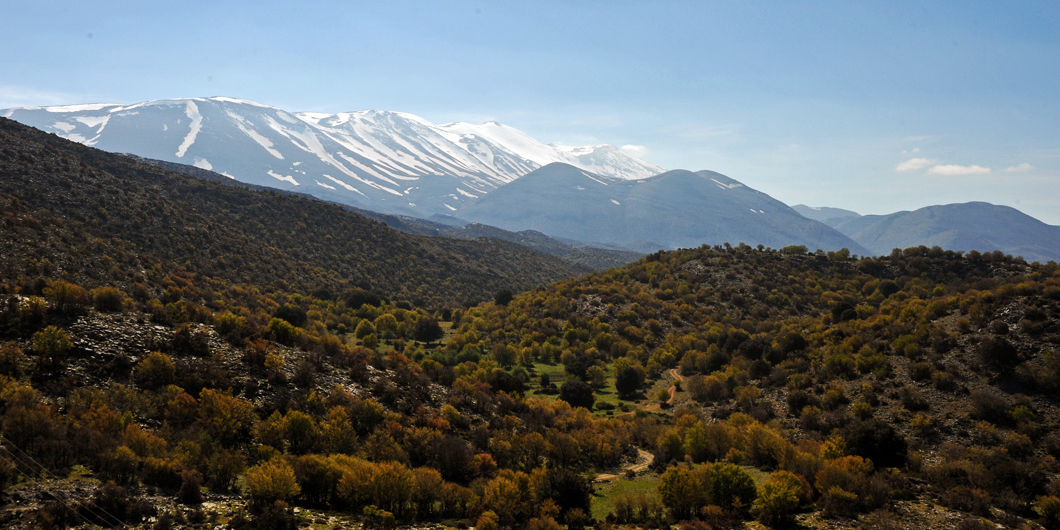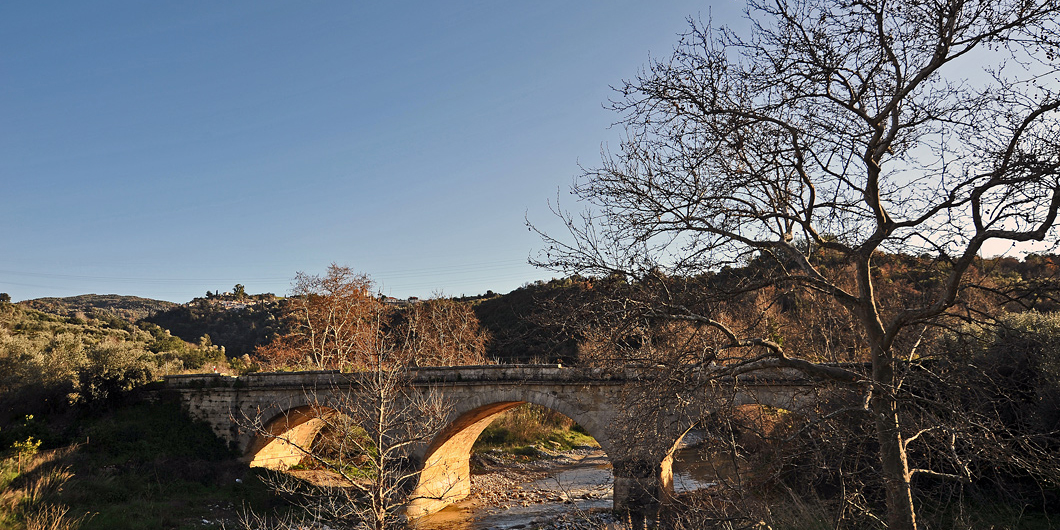This is a route for those who wish to get to know the historical Idi (Mt. Psiloritis) massif (where, according to mythology, the god Zeus was born), together with the most significant of its settlements, monumental nature and sites of ancient civilization.
In the Psiloritis massif area there are several communities which have been living in more or less the same way for thousands of years now, leading a pastoral life which has basically remained unchanged since Antiquity.

At Panormo (1) we can see a large basilica of the 6th century, which was brought to light by an Archaeological excavation; the basilica was most likely destroyed by the Saracens.
There is also the possibility to take a short side-road to Melidoni, to visit the historical cave of Melidoni, which is also known as Gerontospilios.
In Antiquity it was a place of worship, while during the years of the Ottoman rule it was used as a refugefor the Cretan revolutionaries. A charnel house can be seen in the main chamber of the cave; it holds the bones of women, children and warriors who died here of asphyxiation in January 1824, when the Turks who besieged the cave blocked its entrance and set a fire at the opening of the ceiling.
We set off from Pánormo and after the Garazo village (2), which is located on the northern slope of the mountain, drive through the valley of Kato Milopotamos. We then reach the Diskouri Monastery (Monί Diskourίou) which, according to tradition, was founded in the years of Constantine the Great, on the site of an ancient altar dedicated to the Dioskouroi.

From here onwards we follow a route that leads to the heart of Psiloritis.
This landscape has a complex geomorphology and includes many important ecosystems, habitats of rare species of flora and fauna, such as the Cretan wildcat (Felis silvestris cretensis). The highest of the summits are covered in snow from autumn to early summer. On the south and the south-west slopes of the mountain range there are many gorges, caves and caverns. The rugged beauty of the landscape reveals itself even more as the altitude increases.
We make our first stop in the mountainous Milopótamos area at the village of Axos, which is amphitheatrically built at an altitude of 500 metres. A verdant valley with olive groves, vineyards and orchards stretches out below the village.
In the area one can see the tholos tombs that local people call Linospita (or Ellinospita) and the citadel of ancient Oaxos, on a precipitous elevation that rises above the village; the palace of the ancient town, a temple of Zeus (or of Apollo) and a few other rooms used to be up there. In addition, a temple dedicated to Aphrodite was discovered below the citadel, north-east of it.

Next, we travel uphill in a southerly direction, in order to visit the cave of Sfendoni at Zoniana (3), one of the most beautiful caves of Crete that are open to visitors, and one of the largest of Greece.
A guided tour is conducted in the cave; its chambers have rich, impressive decoration of stalactites and stalagmites, a spectacular sight.
Setting off from Zoniana we can also visit, and even pass through, the gorge of Zoniana, which is full of deciduous oaks and is well-known for its stunning geological formations.
As for the village of Zoniana itself, it is worth a visit at the end of July, on the Shepherd and Cheese Festival day; a big feast is organized in the village square and visitors have the chance to taste local cheeses, as well as other local products, and naturally antikristo (lamb cut in large pieces, threaded on special spits and allowed to roast slowly next to an open fire, with spits placed opposite one another), which can be seen roasting away in the street.
After Zoniana we return to the main road and continue to Anogia (4), a village with great musical and artistic tradition, and place of origin of significant personalities of contemporary Cretan culture, such as the late musician Nikos Xylouris, his brother Psarantonis, Vassilis Skoulas and others.
The village also played an important role in the Resistance against the German Occupation, and it paid dearly for it. Disaster struck when the German General Kreipe was kidnapped and sent off to Africa, on August 1944: in came the order that Anogia was to be utterly destroyed, because guerrilla captains from the village took part in the abduction, and the kidnappers were actually stationed in Anogia. That was the third time that the village was destroyed (in 1822, 1867 and 1944).

In Anogia one can visit the family house of Nikos Xylouris which functions as a museum, and be welcomed by his sister. One can also make a stop at one of the traditional coffee shops (cafenίa) in the village square, to taste the famous galaktoboureko (a sweet delicacy with filo pastry and cream). There are also many tavernas where one can taste local specialties such as ofto arni (lamb roast on the spit), sizouma makaronia (pasta cooked in meat broth) and the famous dairy products of the region.
Next, we follow the road which goes uphill south of the village and we then reach the area of Zominthos (5).

Zominthos is a small mountain valley of exceptional natural beauty, which has recently been turned into an archaeological park.
West of the famous water spring of Zominthos a Minoan settlement has been unearthed which, as scientists believe, was an important financial and religious centre of the Minoans. Excavations have revealed a large two-storey building which had approximately 80 rooms.
We next continue southwards, travelling through the area of Agios Mamas, where a chapel of Agios Mamas, the saint of shepherds, can be seen. Then, we reach Petradolakia.
From this point we can take a side road and ascend to the summit of Skinakas, where the Observatory of Skίnakas is located
From the peak one can gaze at the bleak and bare, almost lunar, landscape. Weather-beaten rocks of an amazing diversity of shape and form create a natural setting of rare beauty.
We return to Petradolàkia and continue in a south-westerly direction; a few hundred metres ahead, the plateau of Nida (6) comes into view.

This totally flat plateau, which is situated in the centre of Psiloritis, is covered by a weed named nevrida (Pοlygonum idaeum). Nίda is a prosperous stockbreeding area, where one can see mitata, the characteristic dry-stone shepherds’ dairy huts, scattered everywhere.
At the western side of the plateau the Idaeon Andron , is located; this was the holy cave of the Minoans, and the place where, according to mythology, Zeus, father of the gods of ancient Greece, was born and raised.
The cave acquired great fame throughout the ancient Greek world, due to the purification and initiation rituals that took place there, attracting great numbers of worshippers.
Having reached the end of this marvellous route, and being deep inside the Idaeon Andron, one surely feels that Psiloritis is indeed a dreamy place of myth.







